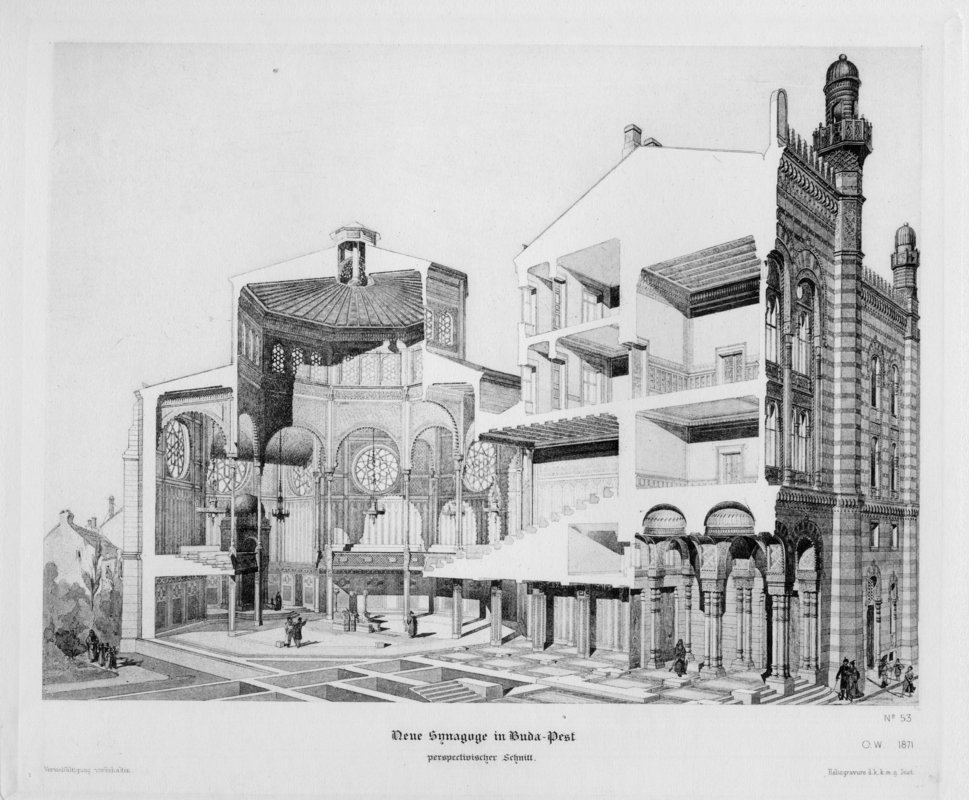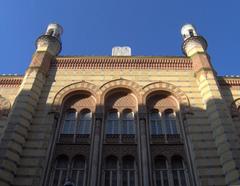
Rumbach Street Synagogue: Visiting Hours, Tickets, and Historical Guide – Budapest
Date: 14/06/2025
Introduction
The Rumbach Street Synagogue, located in the heart of Budapest’s historic Jewish Quarter, stands as a vivid testament to the city’s rich Jewish heritage, architectural innovation, and cultural resilience. Designed by Otto Wagner and completed in 1872, this masterpiece of Moorish Revival architecture is both a sacred space and a vibrant center for cultural life. As one of the three synagogues forming Budapest’s renowned “Synagogue Triangle,” Rumbach not only reflects 19th-century religious diversity but also serves as a living monument to the endurance and creativity of Hungary’s Jewish community. This guide presents comprehensive information for visitors—including opening hours, ticketing, guided tours, key historical events, and practical tips—ensuring you make the most of your visit to this remarkable Budapest historical site.
Historical Overview
Origins and the Status Quo Ante Community
Commissioned in the late 1860s, the Rumbach Street Synagogue was built for the Status Quo Ante community, a group that sought to maintain traditional Jewish practices while resisting both the modernizing Neolog movement and the strict Orthodox approach emerging from the 1868 Jewish Congress. This “moderate” stance influenced not only the community’s liturgy but the synagogue’s social structure and role within Budapest’s Jewish Quarter (Wikipedia; budapest.tours).
Architectural Highlights
Otto Wagner, a 27-year-old Viennese architect destined to become a pioneer of the Secessionist movement, designed the synagogue in a bold Moorish Revival style. The building’s distinctive octagonal sanctuary, crowned by a dome and ringed by galleries, echoes the Dome of the Rock in Jerusalem—a symbolic link to Jewish heritage (rumbachzsinagoga.hu; Architectuul).
Key architectural features include:
- Polychrome brickwork in red, yellow, and brown hues on the four-story facade.
- Minaret-like turrets and horseshoe arches, referencing Islamic and North African motifs.
- Octagonal central hall with stained glass windows and a lantern that floods the sanctuary with natural light.
- Intricate interior mosaics and painted motifs in vibrant blues, reds, and golds.
- Women’s gallery encircling the sanctuary, reflecting period religious customs.
Cultural and Religious Role
From its completion, the Rumbach Synagogue became a focal point of religious, cultural, and educational life for Budapest’s Status Quo Ante Jews. Together with the Dohány Street (Neolog) and Kazinczy Street (Orthodox) synagogues, it formed a symbolic and physical “triangle” representing the spectrum of Hungarian Jewish religious life (offbeatbudapest.com).
Wartime Tragedy and Postwar Decline
The synagogue’s history is marked by periods of both vibrancy and tragedy. During World War II, it was used as an internment and deportation site: in 1941, up to 20,000 Jews were gathered here before being sent to Kamenets-Podolsky, Ukraine. The building suffered further during the Siege of Budapest in 1945 and subsequently fell into decades of neglect (welovebudapest.com).
Restoration and Modern Revival
After years of decay, restoration began in 2007 and was completed in 2018, guided by a commitment to preserve original features such as the mosaic floors, steel bimah lattice, and vibrant decor. The synagogue now serves as both a religious site and a dynamic venue for concerts, exhibitions, and educational events (lovefromhungary.com). The women’s gallery houses exhibitions on Torah scrolls and Pest Jewry, while upper floors include a kosher café and a film screening room.
Visiting Information
Location and Access
- Address: Rumbach Sebestyén utca, District VII, Budapest
- Public Transport: Metro line M2 (Astoria station), tram lines 4 and 6 (nearest stop: Rumbach Street)
- On Foot: Located in the heart of the Jewish Quarter, within easy walking distance of the Dohány and Kazinczy synagogues
- Parking: Limited; public transport or walking is recommended (budapestbylocals.com)
Opening Hours
- Sunday–Thursday: 10:00–18:00
- Friday: 10:00–16:00
- Closed: Saturday (Shabbat) and on major Jewish holidays
- Note: Hours may vary for special events or religious observances—check the official website before your visit.
Tickets and Admission
- Standard admission: 1,500–2,500 HUF (approx. €4–7)
- Discounts: Available for students, seniors, and groups
- Children: Free for under 6 years old
- Where to buy: Online (recommended, especially in peak seasons) or at the entrance
- Guided tours: Additional fee; booking in advance advised (budapestbylocals.com)
Guided Tours
- Languages: Hungarian, English, German, French, Hebrew
- Booking: Advance booking is recommended, especially for non-Hungarian languages
- Content: In-depth history, architectural insights, and access to exhibitions
Accessibility
- Wheelchair accessible: Ramps, elevators, and accessible restrooms are available
- Assistance: Visitors with specific needs should contact the synagogue in advance
Visitor Experience
Dress Code & Etiquette
- Dress modestly: Shoulders and knees covered for all; men may be asked to wear a kippah (provided)
- Behavior: Maintain silence and respectful conduct inside; mobile phones silenced; no eating or drinking in the sanctuary
- Photography: Allowed for personal use (no flash or tripods); avoid photos during services or of worshippers
Facilities
- Gift shop: Books, Judaica, and souvenirs supporting preservation and community activities
- Restrooms: Fully accessible
- Food: No dining inside, but the Jewish Quarter offers many kosher and non-kosher restaurants and cafés nearby
Special Events
The synagogue is a leading venue for the annual Jewish Summer Festival (early September), featuring concerts, art, and culinary events. Year-round, it hosts lectures, exhibitions, and musical performances. Check the official website for the latest programming (welovebudapest.com).
Nearby Attractions
- Dohány Street Synagogue: Europe’s largest synagogue, Jewish Museum, Holocaust memorials
- Kazinczy Street Synagogue: Art Nouveau masterpiece and Orthodox community center
- Klauzál Square: Historic park and food market
- Kazinczy utca: Renowned for kosher bakeries, ruin bars, and vibrant nightlife
Suggested itinerary: Begin at the Rumbach Synagogue, enjoy a guided walk of the Jewish Quarter, lunch at a local bistro, and continue to Dohány and Kazinczy synagogues.
Practical Tips
- Book tickets and tours in advance during festivals or peak tourist seasons
- Bring local currency (HUF); some venues accept euros, but for small purchases, cash is useful
- Wear comfortable shoes; streets in the Jewish Quarter may be uneven
- Budapest weather: Hot summers, cold winters—dress appropriately
- Safety: The area is generally safe, but standard precautions apply, especially after dark
FAQ
What are the synagogue’s opening hours?
Sunday–Thursday 10:00–18:00, Friday 10:00–16:00; closed Saturdays and major Jewish holidays.
How do I buy tickets?
Online via the official website or at the entrance. Advance booking is recommended during busy times.
Is the synagogue accessible?
Yes, it is fully wheelchair accessible.
Are guided tours available?
Yes, in several languages; book in advance for non-Hungarian tours.
Can I take photos inside?
Yes, for personal use without flash or tripods; respect privacy and worship.
Are there dining options nearby?
Yes, the Jewish Quarter is full of kosher and non-kosher restaurants, bakeries, and cafés.
Summary
The Rumbach Street Synagogue is a must-visit destination for anyone interested in Budapest’s Jewish heritage, architectural marvels, or cultural history. Its restored Moorish Revival design and octagonal sanctuary embody both the resilience and the creative spirit of Central European Jewry. With accessible facilities, multilingual guided tours, and a prime location, the synagogue offers a welcoming and enriching experience for all visitors. Plan your visit to include neighboring synagogues and the vibrant Jewish Quarter, and immerse yourself in one of Budapest’s most storied districts.
For current visiting hours, ticketing, and event information, visit the official site. For personalized itineraries and more insider tips, download the Audiala app and follow us on social media.
Sources
- This guide is based on authoritative sources, including:








































































































































































